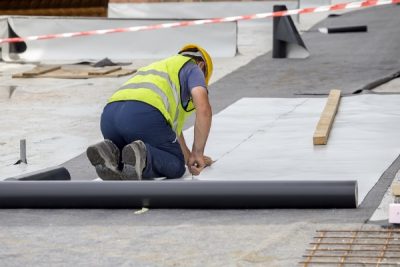If you’re searching the market for a new flat roof system, you’ve probably come across or heard of TPO membrane quite a lot. The popularity of this roofing option is not unfounded. Many consider it as one of the best flat roof systems around. But as that may be so, given the weight of the decision, a lot more thought has to go into this. What is a TPO roof, exactly? And are there any TPO roofing problems you should know about?
What is TPO – An Introduction

TPO is one of the top choices for commercial roofing.
In the building industry, TPO stands for thermoplastic polyolefin – a synthetic rubber compound that has been extensively used for roofing since the late 1980s. It is made up of a single-ply synthetic membrane, used to cover flat and low-slope roofs.
TPO membranes can be applied directly over old/existing roofing material or a bare roof deck with adhesive or mechanical fasteners. The exposed surface of a TPO roof is usually a reflective white color, which gave it the moniker, “white roof.” But hold up! Don’t let that mislead you because TPO is also manufactured in other more attractive or less vibrant shades. For colder climate like Toronto, black or tan may be a better way to go!
The increasing popularity of TPO as the roofing-material-of-choice for commercial roof restorations is mainly due to its energy-efficiency and affordable installation price tag. Moreover, the material is reinforced with flame retardants and UV absorption agents. In the face of shrinking budgets and high power consumption rates, these are very attractive perks.
The Pros and Cons of TPO Roofing
As one of the least-costly but effective options around, it’s not so surprising to find out that the TPO roofing system tops the list as the membrane market’s fastest-growing segment. After going through numerous formulation changes over the years to become the durable roofing membrane we know today, the success is well-deserved. But as with most things, TPO roofs have both good and – uhm – not so good qualities.
Let’s take a look at the advantages of TPO roofs:
-
Durability and Longevity
Being a modern roofing solution, TPO boasts of strength and resilience to wear and tear and other forces of nature. When properly installed, the life expectancy of TPO membranes can last for decades. Of course, thicker TPO membranes tend to be more durable than thinner ones.
Because it is a newer material with more modern technology than its counterparts, it’s possible to fuse the seams together, thus making them up to four times stronger. Since seams are often the weakest link in roofing systems, this possibility gives you ones less thing to worry about.
-
Cost – Efficiency
The main reason for TPO’s growing fan-base – cost efficiency. Ever since, the TPO membrane’s most attractive feature is the fact that it’s likely to save you money in the long run. With its built-in reflective technology, it helps prevent heat absorption, resulting in better energy savings. What’s even better is that you don’t necessarily have to pick a white TPO roof to cut energy costs – all the colors are UV resistant and energy-efficient.
-
Easier Installation Process
TPO membranes often have wider sheet sizes compared to other flat roof materials like PVC and EPDM – and they’re lighter too! The advantages in weight and size may not seem like it’s a big issue, but it actually makes installation easier and faster. The lesser number of seams is also a definite plus!
-
Ability to Handle Heat Fluctuations Well
Another wonderful thing about TPO roofing systems is that they can handle thermal expansion and contraction well. This makes them ideal for buildings located in places that experience heat fluctuations or where the temperature can dip very low.
-
Ability To Match Aesthetics
TPO roofs usually come in white, black, and grey colors but some manufacturers offer a range of color options. This obviously means more aesthetic choices and a better chance of finding a shade that will match the look and feel of the building structure.
Now that we’ve highlighted the upsides, it time to tackle the downsides and TPO roofing problems to be aware of:
-
Cost
Because the budget is always a primary concern let’s get this one out of the way.
So here’s the deal: When compared to EPDM, TPO roofing costs are higher. Also, TPO installation is a bit more expensive.
What’s the more economical choice, then? That — is quite tricky. EPDM roofing may be cheaper when it comes to upfront costs, but TPO has energy efficiency under its belt.
-
Newness
Technically, TPO has been around for decades, but its formulation went through constant changes and upgrades. In fact, researches and studies on developing better TPO membranes are currently underway.
The TPO roofing systems we see today are a product of the latest TPO technology. While that does not sound like a bad thing, it has its drawbacks. Since they’re still new to the market, nobody can tell for sure how they’ll stand the test of time. While many TPO roofs are performing as promised, there have been complaints about seam failures and cracked membranes over the last few years.
-
Degrading Adhesives

Proper TPO roofing installation ensures its durability and longevity.
Yes, the TPO membrane is UV resistant but the adhesives that seal the seams of the membranes together, unfortunately, are not. When directly exposed to the heat of the sun, the adhesives degrade over time and cause leaking on the seams.
This is why proper installation is vital. The membrane sheets should be attached in a way that they overlap and protect the adhesives from direct exposure to UV rays.
-
Expired Warranties
Warranties on TPO roofing systems vary greatly. Some companies have 20 or 30-year warranties while others only offer 10 or 15 years. That said, it’s crucial to stay on top of your warranty to avoid expensive maintenance and repair costs when TPO roofing problems occur.
Final Thoughts
All aspects considered, it’s safe to say that TPO membrane is an excellent choice for commercial or even residential flat roof systems. But because it’s fairly new technology, one should only entrust the job to experienced contractors. The quality and durability of the installation heavily depend on the expertise of the people behind it.
Are You Looking for A Reliable Commercial Roofer in Toronto? Look No Further.
Cox Roofing Systems is a Firestone-qualified contractor. You can bank on us to only use superior roofing materials and deliver quality roofing systems every time.
For more information about TPO and other flat roofing options, call us now and get a free consultation!





